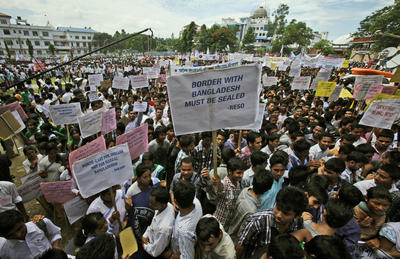The scale of the violent clashes, which began in July, has been huge, killing about 100 people. Nearly half-a-million people belonging to both communities have fled their homes, seeking safety in official shelters.
Assam violence has set off a chain reaction in other parts of India. This includes in a totally unexpected form in India’s IT cities like Bangalore, Pune and Hyderabad, which attract youth from the northeast seeking better education and job prospects. Rumours, spread through bulk SMS by some sections, warned of attacks causing many to flee back home. From Bangalore alone there was an exodus of nearly 30,000 NE people.
The scale of the Assam clashes, and its unprecedented repercussions in far off metros, has put the riots and the issue of illegal migration from Bangladesh and the region’s continued economic backwardness in national and international media spotlight. The flare up opens an opportunity for India to develop a broader approach for addressing the complex problem in the NE region, with much of its geographical area abutting international borders with Bangladesh, Myanmar, China and Bhutan. This region is also prone to unrest, not-so-latent ethnic conflicts and inter-state border disputes.
The Assam riots have coincided with Buddhist and Rohingya Muslim clashes in the Myanmar state of Rakhine near the Bangladesh border, displacing some 60,000 Muslims from their homes. The Myanmar incident has also invited a strong reaction from the Islamic world. In its extraordinary summit meeting, held in early August at Mecca in Saudi Arabia, the Organisation of Islamic Cooperation (OIC) protested against ‘the continued recourse to violence by the Myanmar authorities against the members of this minority and their refusal to recognise their right to citizenship’. The OIC was also critical of Bangladesh for not allowing Rohingya Muslim refugees entry into the country. Dhaka, on the other hand, has expressed its inability to take more refugees, as it is already saddled with 200,000 to 300,000 of them. Turkey and the OIC have sent separate teams to the riot-affected region in Myanmar for assessing the conditions of the minority Muslims and the scale of assistance needed. The ASEAN secretariat has also asked member countries to extend ‘humanitarian assistance’ to Myanmar (an ASEAN member) and advised them to look for a constructive role for the regional group in finding a long-term solution.
Pakistan, Tunisia and several other Muslim nations have voiced concern over the plight of Muslims in Myanmar. According to the Indian online news agency Rediff, the Taliban in Pakistan has warned of reprisals against Myanmar Buddhists. The instability caused by the Rohingya–Buddhist confrontation has opened the doors for international intervention in India’s proximity — that should be another worry for India.
India’s new President, Pranab Mukherjee, a veteran politician and a former foreign minister, presumably has taken note of the above developments within India and the growing international concern about the inter-religious conflicts in India’s eastern neighbourhood. That may have persuaded President Mukherjee to insert the following paragraph into his first national address on the eve of Independence Day: ‘It is a fact of our geopolitical environment that some problems transcend borders. The South Asian Association for Regional Cooperation (SAARC) was created 27 years ago to find solutions through dialogue and by mutual cooperation create the rapid economic growth that is the only long-term answer to problems like migration and uneven development. SAARC must acquire vigour to fulfil its mandate’. This is the first time that India’s head of the nation has thrown up the idea of addressing the acute economic backwardness, (and the related migrants issue) of the northeast under the SAARC umbrella. As demanded by protocol, Mukherjee’s statement is cryptic and only mentions SAARC.
Mukul Sangma, chief minister of Meghalaya, faced with the Bangladesh-migrant problem, has supported the idea. He told media recently in Goa that ‘the long international boundaries should be converted into boundaries for growth’. Other encouraging signs are visits by teams from Bangladesh and Myanmar to the northeast states and vice versa for discussing common development plans including improved infrastructure. Officials from the Thai government have conducted market surveys in the border town of Moreh (Manipur) for assessing trans-border trade potential.
Thus far the limited movement in cross border trade and other areas is taking place in an essentially bilateral frame work. Mukherjee’s suggestion is to take this to a new level in a larger political and economic boundary. The idea is for SAARC, and possibly ASEAN, to convert a zone of conflict and instability into an economic engine of some consequence. A UN body like the Economic and Social Commission for Asia and the Pacific (ESCAP), as and when it is invited to buy into this idea, could provide an overarching bridge, along with resources and expertise.
S. Narendra, former Information Advisor to the Prime Minister of India, Government Spokesperson, served as South East Asia Correspondent for All India Radio.

